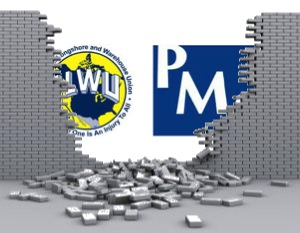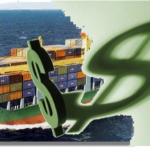New ILWU Tentative Contract Details & Fallout
Things were getting tense at West Coast ports when a tentative agreement for a new International Longshore & Warehouse Union (ILWU) contract was finally reached last week. The union and Pacific Maritime Association (PMA), representing the employers at the docks, announced the tentative deal Wednesday after vessel delays had been piling up for a couple weeks at the West Coast ports.

Talks had grown more and more contentious in the 13 months since the previous contract expired. Union jurisdiction, automation, and wages all played roles in the difficult negotiation process. Many shippers took the strategy of diverting cargo to East and Gulf Coast ports, which turned out wise as labor action disrupted West Coast ports and even led to terminal shutdowns by the end of negotiations.
The deal will still have to be ratified. While there are usually some small groups amongst the dockworkers who oppose ratification, there normally is not much drama in the process. There’s no reason to expect failure to ratify this contract.
Contract Details
Details of the new ILWU contract are only beginning to come out. In the Journal of Commerce (JOC), Bill Mongelluzzo reported on what details have been released, and it’s a big score for dockworkers:
ILWU members will receive a 32% wage increase over the course of the 6-year contract along with a $70 million bonus to be split equally amongst them. As per usual, the pay increase will be retroactively applied from the date the previous contract expired, which was July 1st, 2022.
Deal Prevented Strike or Lockout
With labor action backing up ships and delaying both the export and import of cargo at West Coast ports over the last couple weeks, tensions boiled over. The union and employers began threatening a strike and a lockout, respectively, according to reports. The parties gave themselves a deadline to reach a deal to prevent a full shutdown of West Coast ports.

Mongelluzzo reported:
This week began on a tense note, as sources said negotiators for the ILWU and PMA were working under a self-imposed 72-hour deadline to reach a deal before a possible coastwide employer lockout or strike.
This is the point at which it appears the Biden Administration finally got involved as shippers have been begging the White House to do throughout the year-plus of tumultuous negotiations. Mongelluzzo added:
US Labor Secretary nominee Julie Su also arrived in San Francisco Monday, urging negotiators to reach an agreement and remaining in the Bay Area to offer further assistance until the tentative contract was agreed.
It’s unclear how much of an effect Su had on the situation. Mongelluzzo reported last Monday, when Su arrived:
The PMA and the International Longshore and Warehouse Union (ILWU) declined comment Monday when asked if they would meet with Su.
The focus of his article then, as it was for reporting in general at that moment, was on disruption from labor action at the Ports of Seattle, Los Angeles, and Long Beach. Conflict between the PMA and ILWU was clearly high, and by current accounts, we were closer to a strike or lockout than most realized.
Shippers Deserve Better
It seems I write this every time the ILWU and PMA negotiate a new contract, but shippers deserve better.
In a FreightWaves article, Greg Miller reported, “ILWU President Willie Adams said the union will now ‘turn our full attention back to the operation of the West Coast ports.'”
Dockworkers’ jobs are the operation of West Coast ports. That they turn away from that every time a new contract is to be negotiated is unacceptable. Over and over again, shippers have paid the price. Could we, for a change, start seeing the ILWU continuing to do its job without causing disruption while negotiations happen?
I suppose that would be too much to ask from these very well-paid workers.
Deal Just Beats Peak Season’s Full Swing
At least shippers can find some solace in this deal being reached just before peak season hits full stride. Economic uncertainty has the peak season looking weaker than it could. However, we are seeing a peak season, as I predicted. Miller laid out what we’re looking at this peak season:
Volumes to the West Coast have been seasonally rising, in line with pre-pandemic patterns. The Port of Los Angeles handled 409,150 twenty-foot equivalent units of imports in May, up 19% from April and up 64% from the recent low in March.
As of Monday, there were 58 container ships en route to the ports of Los Angeles and Long Beach from Asia, compared to 46 a month before and 47 two months prior.
Port of Los Angeles Executive Gene Seroka said his port is operating at about 70% of capacity. Of the 30% shortfall, he said half was due to macroeconomic issues and half was due to cargo switched to East Coast and Gulf Coast ports as a result of labor concerns at West Coast ports.
“If we can get a labor deal soon and the economy doesn’t falter, we’ll have a strong second half,” Seroka said on Tuesday.
They got the labor deal. Now it’s up to the economy.
The tentative ILWU contract agreement being reached last week was crucial for the ports and shippers. Thus, I do give kudos to the ILWU for going to the table and making an agreement before we got any deeper into this peak season. By all accounts, with the new agreement made, the union has gotten fully back to work, ending the labor action it was executing. That’s good news.
What will be interesting to watch now is how much of the market gain East and Gulf Coast ports made during these negotiations will stay at those ports rather than returning to the West Coast ones.





